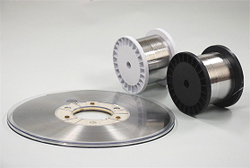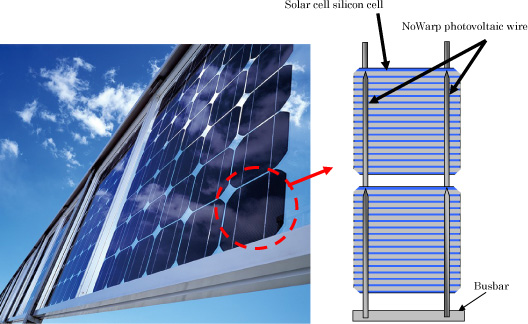2010 The former Hitachi Cable News Release
Information (including product prices, product specifications, details of services, launch dates, inquiry information, and URLs) contained in this news release is current as of the date of the press release but is subject to change without notice. Please note that details may differ from those effective on the search date.
Hitachi Cable announces New production equipment for NoWarp photovoltaic wire for solar cell use introduced in Malaysia
Supply system network of three facilities worldwide established
In response to growing demand for the NoWarp photovoltaic wire (solder-plated rectangular wire)*1 used in solar cell module conductors, Hitachi Cable, Ltd. will introduce new production equipment at Hitachi Cable (Johor) Sdn. Bhd. of Malaysia, a new production facility to take its place alongside Hitachi Cable Fine-Tech, Ltd. and Hitachi Cable (Suzhou) Co., Ltd. Full-scale operation of the new equipment is slated to get underway in August 2010.
In solar cell modules, photovoltaic wire connects the individual cells that make up a solar cell, serving as a conductor that collects the electric power generated. Wire-rolling, wiredrawing, and plating technologies accumulated during years of producing a wide range of wires and cables, Hitachi Cable launched production of photovoltaic wire in 2000. Today, it sells photovoltaic wire under the NoWarp brand name.
Representing the mainstream in solar cell modules, crystalline silicon solar cells have been made slimmer in recent years for increased production efficiency. In thinner cells, however, the individual cells are more susceptible to the thermal stress generated when connected to photovoltaic wires, which sometimes results in warp. Photovoltaic wires must be flexible enough to absorb this thermal stress and to resist cell warp.
Hitachi Cable's efforts to optimize thermal processing conditions have won NoWarp photovoltaic wire high marks for achieving flexibility while maintaining high electrical conductivity. This wire currently holds a roughly 20% share of the world's photovoltaic wire market.*2
Growing interest in energy conservation and efforts to prevent global warming have led to anticipated annual growth rates for solar cell module output capacity averaging 22%. By 2015, the corresponding market is projected to grow to roughly 3.3 times in its size in 2009.*3 This anticipated demand has energized the production of solar cell modules around the world, as existing module makers seek to expand production and a succession of new parties venture into the market. This trend has been accompanied by growing demand for photovoltaic wire, creating a need to develop supply structures across a broad regional basis.
Investing roughly 500 million yen, Hitachi Cable has decided to introduce production equipment at Hitachi Cable (Johor) of Malaysia, making it a new production facility for photovoltaic wire. Full-scale operations are slated to get underway in August 2010.
By establishing this new production facility in addition to existing facilities in Japan and China, the Hitachi Cable Group is seeking to expand net sales of wiring materials for solar cell use—primarily NoWarp products—from approximately 4 billion yen in fiscal 2009 to 9 billion yen in fiscal 2012. Plans call for regionally optimized production as well as future enhancements in new product development and production capabilities.
| *1 | NoWarp is a registered trademark of Hitachi Cable, Ltd. in Japan. |
| *2 | Hitachi Cable estimates based on data from multiple studie |
| *3 | Source: Fuji Keizai, New Market of Power & Energy System 2010 |
| *4 | Each other brand name that appears here is the trademark or registered trademark of their respective owners. |
External views of NoWarp photovoltaic wire
Example of use in a solar cell module

